On February 28th of this year, Peter Kotowicz, an archaeologist with the Historical Museum of Sanok, received a phone call from a history-loving friend named Tomasz Podolak who told him he had found something interesting, possibly treasure, in the village of Pakoszówka near Sanok in southeastern Poland. Podolak has discovered ancient bronze artifacts before that are now in the museum — he received an award by the Minister of Culture last year for the finds and his reporting of the objects while they were still in situ — so as soon as Kotowicz hung up he got in his car and started driving.
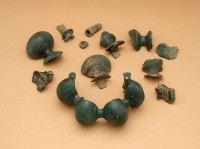 When he arrived at the find site, he saw several shallow wells in the earth, each containing some bronze fragments. One of them held a larger piece with only the tip showing above the soil. At first glance, Kotowicz was unable to identify the objects although he suspected they might be of Celtic origin. When he excavated the initial finds and an area of approximately 20 feet around them, he realized the fragments were all pieces of a single item of a jewelry: a bronze anklet in a characteristic Celtic design from the 3rd century B.C.
When he arrived at the find site, he saw several shallow wells in the earth, each containing some bronze fragments. One of them held a larger piece with only the tip showing above the soil. At first glance, Kotowicz was unable to identify the objects although he suspected they might be of Celtic origin. When he excavated the initial finds and an area of approximately 20 feet around them, he realized the fragments were all pieces of a single item of a jewelry: a bronze anklet in a characteristic Celtic design from the 3rd century B.C.
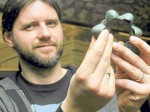 The largest piece formed about half the ring. The traces of two hinges are visible on the end pieces. The edges of the fragments suggest the jewel broke apart in antiquity rather than as a result of modern activity. As one piece was found more than 50 feet away from the central cluster, it’s possible the anklet had been deliberately destroyed and its fragments strewn about, perhaps for ritual purposes.
The largest piece formed about half the ring. The traces of two hinges are visible on the end pieces. The edges of the fragments suggest the jewel broke apart in antiquity rather than as a result of modern activity. As one piece was found more than 50 feet away from the central cluster, it’s possible the anklet had been deliberately destroyed and its fragments strewn about, perhaps for ritual purposes.
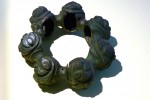 Known by German term hohlbuckelringe, meaning hollow bulge ring, these ornaments are among the most distinctive Celtic designs. You can follow the trail of Celtic expansion into eastern Europe in the 3rd century B.C. by following the hohlbuckelringe like breadcrumbs. They first appear in southern German and the territories of the Boii tribe in what is today Bohemia, Czech Republic, in the early 3rd century. As the Celtic tribes moved east, so did the hohlbuckelringe. Examples have been unearthed in Slovakia, Hungary, Romania, Bulgaria, Greece and southeast from there into Asia Minor.
Known by German term hohlbuckelringe, meaning hollow bulge ring, these ornaments are among the most distinctive Celtic designs. You can follow the trail of Celtic expansion into eastern Europe in the 3rd century B.C. by following the hohlbuckelringe like breadcrumbs. They first appear in southern German and the territories of the Boii tribe in what is today Bohemia, Czech Republic, in the early 3rd century. As the Celtic tribes moved east, so did the hohlbuckelringe. Examples have been unearthed in Slovakia, Hungary, Romania, Bulgaria, Greece and southeast from there into Asia Minor.
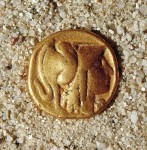 While Celts were known to have settled in the Sanok area during the La Tène period (450 B.C. – 1 B.C.), very little of their material culture has been recovered from this part of Poland. Almost nothing was known of the Celtic presence in the San river valley until excavations in the 1990s found evidence of settlement like pottery sherds, fragments of a glass bracelet, a hearth, an iron sword and, the most prized Celtic artifact in the Historical Museum of Sanok, a gold coin discovered by happenstance in the village of Trepcza.
While Celts were known to have settled in the Sanok area during the La Tène period (450 B.C. – 1 B.C.), very little of their material culture has been recovered from this part of Poland. Almost nothing was known of the Celtic presence in the San river valley until excavations in the 1990s found evidence of settlement like pottery sherds, fragments of a glass bracelet, a hearth, an iron sword and, the most prized Celtic artifact in the Historical Museum of Sanok, a gold coin discovered by happenstance in the village of Trepcza.
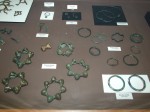 So while this newly discovered anklet is in pieces, incomplete and plain in decoration (more elaborate versions were made from precious metals and added swirls and bumps to the bulges), it’s a significant and unique find. No other examples of this archtypical form of Celtic female adornment have been unearthed in the region. Kotowicz believes that after the gold coin and the iron sword in the Regional Museum in Rzeszów, this ankle ring is the most exceptional Celtic artifact south of the Carpathians.
So while this newly discovered anklet is in pieces, incomplete and plain in decoration (more elaborate versions were made from precious metals and added swirls and bumps to the bulges), it’s a significant and unique find. No other examples of this archtypical form of Celtic female adornment have been unearthed in the region. Kotowicz believes that after the gold coin and the iron sword in the Regional Museum in Rzeszów, this ankle ring is the most exceptional Celtic artifact south of the Carpathians.
The location where the hohlbuckelringe was discovered has not previously been considered of archaeological import. Archaeologists plan to thoroughly scan the area with metal detectors. They’re also hoping to secure funding for more in depth research and additional excavations, but that will depend on the assessment of the regional conservation office.
The ankle ring is now being conserved at the museum in Sanok. It will go on display later this year in one of the underground exhibition halls of Sanok castle.